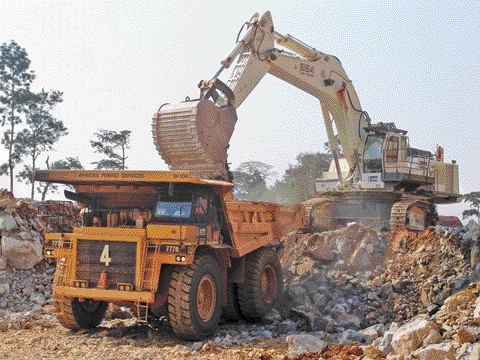Vancouver — With one gold mine up and running in Ghana,
Chirano poured its first gold last fall and is now on track to produce 123,000 oz. annually over its initial 8.5-year mine life. The open-pit mine began operations with proven and probable reserves of 17.8 million tonnes grading 1.9 grams gold per tonne, or about 1 million contained ounces gold.
The Chirano deposit lies within the Bibiani gold belt and along strike of the Bibiani gold mine operated by
The company also promoted geologist Hugh Stuart to vice-president of exploration. Prior to joining Red Back, Stuart was Ashanti’s exploration manager at the Geita gold project in Tanzania, where he was credited with the discovery of the 10-million-oz. Nyankanga deposit. Geita is now East Africa’s largest producing gold mine.
Stuart also discovered Enchi, Red Back’s regional exploration project, which covers a major 50-km-long section of the eastern margin of the Sefwi belt. The project includes areas where small high-grade underground mines were exploited in colonial times. Widespread artisanal workings also exist on the property, including both alluvial and small bedrock operations.
Previous operators explored Enchi in the past, reportedly with limited success, though a small resource was defined at one prospect. Red Back says this historic activity focused on second-order splay structures and did not test the main belt margin, now viewed as the most prospective area of interest.
The company reported its first discovery at Enchi last fall, after identifying two targets, Boin Valley East and West, in weathered Birimian volcanics and sediments. Both were initially tested with five trenches and 44 shallow rotary-air blastholes to a maximum depth of 70 metres. Boin Valley East returned relatively low grades (below 1 gram), but Boin Valley West returned very encouraging results, including 15 metres of 3 grams and 12 metres of 1.6 grams gold per tonne.
In late fall, 2005, the company carried out a reverse-circulation drill program of 7,200 metres in 57 holes to test the two main structures at Boin Valley West, the Main and North zones. This program intersected mineralization over a combined strike length of 2.7 km. Highlights include: 20 metres of 1.57 grams gold, 16 metres of 2.26 grams, 12 metres of 3.82 grams, 21 metres of 2.5 grams, and 17 metres of 3.27 grams gold.
While not all results were in hand by year-end, results from the first 33 holes (from a total of 45) at the Main zone showed a strike length of 1.2 km, based on 100-metre-spaced lines. The remaining 12 holes, if mineralized, would potentially extend this another 400 metres.
Results are not yet in hand from all holes drilled at the North zone at Boin Valley West (which strikes parallel to the Main zone), but the zone has been tested over a strike length of 1.1 km.
Late in 2005, the drills were moved to the Boin Valley East prospect, 5 km east, to test areas where trench intercepts had returned values of up to 60 metres at 0.8 gram gold. This drilling will continue into early 2006.
Red Back is also exploring several targets near its Chirano mine. Among them is the Akwaaba prospect, where intercepts of up to 15 metres grading 14.26 grams gold per tonne were previously reported. This intercept was obtained near the base of the current open pit, and is believed to represent a high-grade shoot plunging north below the pit.
The ongoing drill program is designed to test this shoot, now estimated to be up to 100 metres wide, to a depth of 150 metres below the pit base. The goal is to define an easily accessible, high-grade resource that would be mined by underground methods.
Initial exploration, including soil-sampling and trenching programs, has also better defined the Abodoabo discovery, 5 km north of the Chirano mine complex. A large soil anomaly was defined over a strike length of 4.6 km within a similar geological setting to the Bibiani gold mine 10 km north.
A first phase of trenching tested a 900-metre strike length of the large anomaly. Highlights are 6.82 grams over 12 metres; 3.66 grams over 10 metres; and 2.1 grams over 14 metres. More trenching is planned, followed by drilling programs, assuming positive results.
Red Back believes both early stage targets offer potential for resource expansion that could extend the life of the Chirano mine. Drilling is ongoing at the Enchi regional project, which so far appears to have potential for a satellite deposit, if not a stand-alone operation.


Be the first to comment on "Red Back ramps up exploration in Ghana"